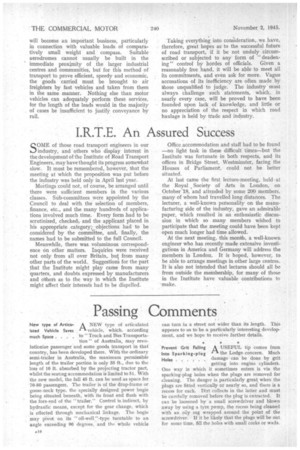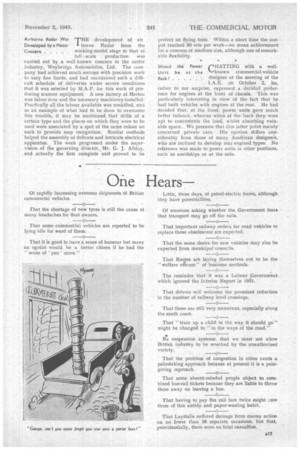Passing Comments
Page 18

Page 19

If you've noticed an error in this article please click here to report it so we can fix it.
A NEW type of articulated vehicle, which, according to " Truck and Bus Transportation" of Australia, may revolutionize passenger and some goods transport in that country, has been developed there. With the ordinary semi-trailer in Australia, the maximum permissible length of the trailer portion is only 35 ft., due to the loss of 10 ft. absorbed by the projecting tractor part, whilst the seating accommodation is limited to 51. With the new model, the full 45 ft. can be used as space for 70-80 passengers. The trailer is of the drop-frame or goose-neck type. the specially designed power bogie being situated beneath, with its front end flush with the fore-end of the "trailer." Control is indirect, by hydraulic means, except for the gear change, which is effected through mechanical linkage. The bogie may pivot 'on its "oil-well "-type turntable to an angle exceeding 90 degrees, and the whole vehicle
much Space . . . can turn in a street not wider than its length. This appears to us to be a particularly interesting development, and we hope to receive further details.
Prevent Grit Falling A USEFTJL tip comes from Into Sparking-plug r-1. the Lodge .concern. Much
Holes damage can be done by grit getting into engine cylinder.. One way in which it sometimes enters is via the sparking-plug holes when the plugs are removed for cleaning. The danger is particularly great when the plugs are fitted vertically or nearly so, and there is a recess for each. Dirt collects in the latter and must be carefully removed before the plug is extracted. It can be loosened by a small screwdriver and blown away by using a tyre pump, the recess being cleaned with an oily rag wrapped around the point of the screwdriver. If it be likely that the plugs will be out for some time, fill the holes with small corks or wads. Airborne Radar 'Na Developed by a Motor Concern
THE development of air borne Radar from the working-model stage to that of.
fullscale prciduction was carried out by a well-known concern in the motor industry, Weybridge Automobiles, Ltd. The coin pany had achieved much success with precision work to very fine limits, and had maintained such a difficult schedule of deliveries under severe conditions that it was selected by M.A.P. for this work of pro. clueing scanner equipment. A new factory at Merton was taken Over and the necessary machinery installed. Practically all the labour available was unskilled, and as an example of what had to be done to overcome this trouble, it may be mentioned that drills of a certain type and the places on which they were to be used were associated by a spot of the same colour on each to provide easy recognition. Similar methods 'helped the assembly of delicate and intricate electrical apparatus. The work progressed under the supervision of the governing director,_ Mr. G. J. Adiday, and actually the first complete unit proved to be
perfect on flying tests. Within a short tinae the output reached 30 sets per week—no mean achievement for a concern of medium size, although one of remarkal)le flexibility
Shoud thePower CHATTING with a wellUnit be at the'-'known commercial-vehicle
Back designer at the Meeting of the
f.A.E. on October 2; he, rather to our surprise, expressed a decided preference for engines at the front of chassis. Thiswas particularly interesting in view of the fact that he had built vehicles with engines at the rear. He had decided that, at the front; power units gave much better balance, whereas when at the 'hack they, were apt to concentrate the load, whilst absorbing valuable space. We presume that this latter point mainly concerned private cars. His opinion. differs considerably from those of many American designers, who are inclined to develop rear-engined types. No reference was made to power units in other positions, such as amidships or at the -side.




















































